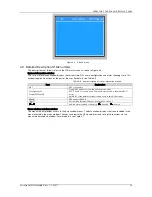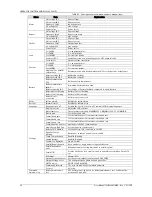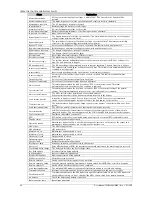
BATTERY
User Manual 10H52246UM60 - Rev. 1 - 01/2017
53
6.3
UPS Battery
The UPS normally uses valve-regulated batteries. 'Valve-regulated' or 'sealed type' batteries correspond to the old
'maintenance free' type.
Valve-regulated batteries are not completely sealed; in fact they are designed to permit a small quantity to escape,
especially when they are over-charged. The volume of the gas that escapes is less than the water injection batteries.
However, when installing the battery it is important to take temperature rises into account and leave enough room
to ensure good ventilation.
Also, valve-regulated batteries are not maintenance free. They must be kept clean and inspected regularly to make
sure that the connection is still good and not affected by corrosion. For details, please refer to para
6.11 Battery
Maintenance
.
We recommend that you do not connect more than 4 strings of batteries in parallel. Do not mix batteries of different
brands, types or ages in the same system. Otherwise, the resulting inconsistency will cause some of the batteries to
over-discharge or under-charge frequently, eventually causing them to fail prematurely, thus compromising the
back-up time of the entire string.
Batteries must be stored in the fully charged state. The battery will lose some capacity due to self discharge during
shipping or storage. Charge the battery before use. During storage, ensure that the ambient temperature remains
within the range -15°C ~ +45°C (the optimum temperature range is 20°C ~ 25°C). To compensate for the self
discharge, recharge the batteries once every 3 months while they remain in storage. This interval may vary
depending on the type of batteries. For details, refer to the battery manufacturer's specifications.
It is very important to charge the battery fully before carrying out onsite test on the battery backup time. The test
may take several days. Therefore, it should be conducted after the battery has been subject to uninterrupted float
charging for at least one week.
The battery performance will increase once it has been in use for several weeks or subjected to two to three charge
and discharge cycles.
To avoid overcharging or undercharging the battery over-charge or under-charge, set the battery management
parameters according to the equalizing/float charge voltage and temperature compensation factor specified in the
manuals provided by the battery manufacturer. Please charge the battery immediately after discharge.
6.4
Installation Design Precautions
Note
1. The precautions that must be taken when installing, using and servicing the battery are described in the relevant battery
manual provided by the battery manufacturer. 2. The safety precautions described in this section include important factors
that must be taken into consideration when designing the installation.
3. The design results may vary depending on local conditions.
6.5
Battery Installation Environment And Number Of Batteries
6.5.1
Installation Environment
Fresh air volume (EN50272-2001)
The battery installation environment must be ventilated. The following fresh air ventilation requirements must be
satisfied while the battery is in use:
Q=0.05 x n x Igas x Crt x 10–3[m3/h]
Where:
Q=The fresh air ventilation volume per hour, the unit is m3/h
n=Number of cells
Igas=The gas generating current density under battery float charging or boost charge conditions, the unit is mA/Ah
Igas=1, under the float charging condition at 2.27V/cell
Igas=8, under the boost charge condition at 2.35V/cell
Crt=20hr battery rated capacity
















































